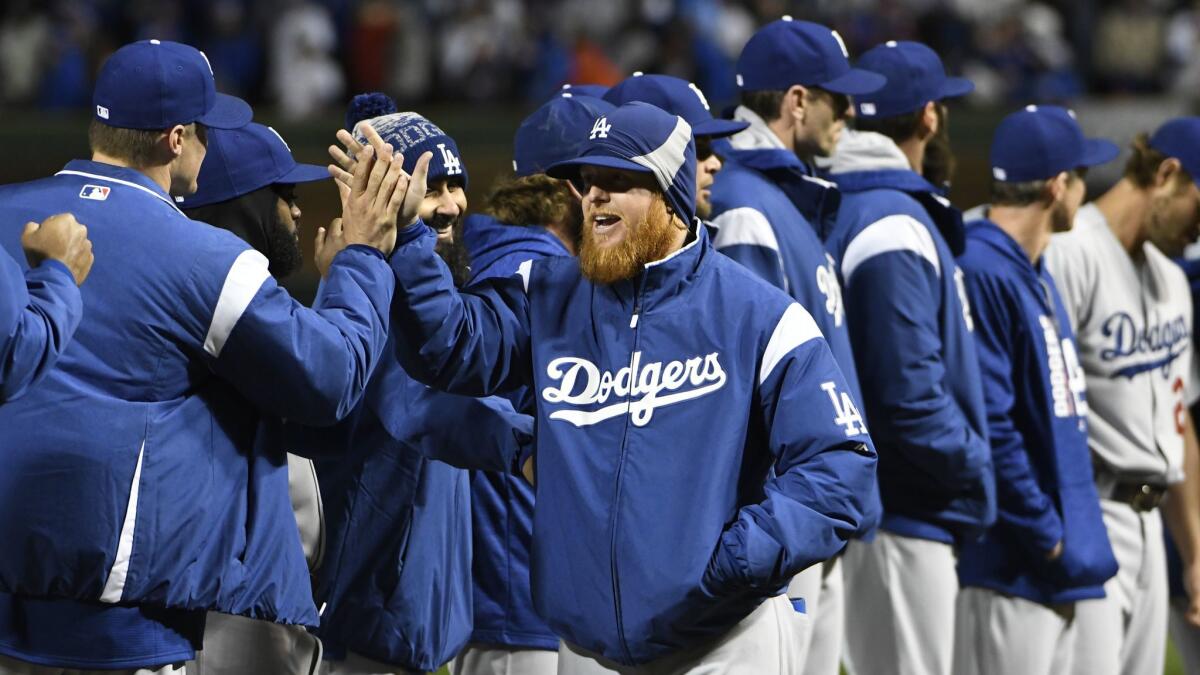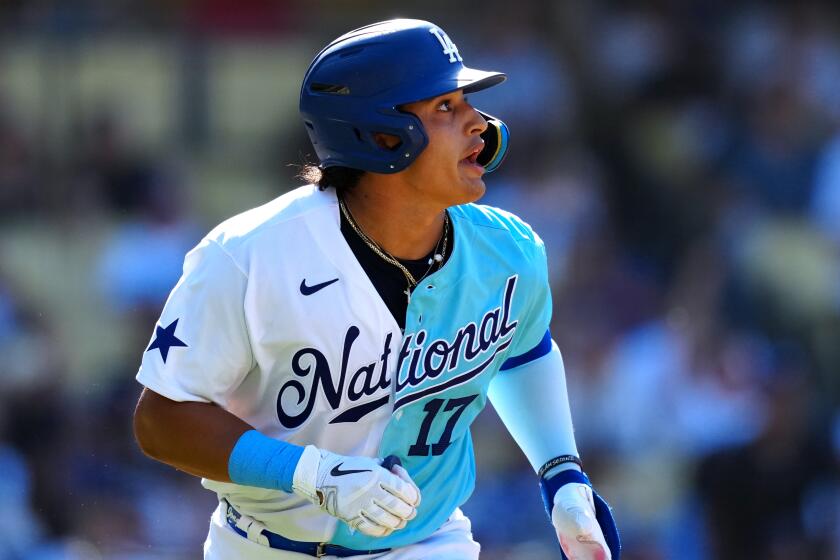Dodgers Dugout: No spitting in baseball?

Hi, and welcome to another edition of Dodgers Dugout. My name is Houston Mitchell and today we look at what new health-related rules could be in place if baseball returns this season.
You know all that spitting baseball players do? That may not be happening soon.
Are you a true-blue fan?
Get our Dodgers Dugout newsletter for insights, news and much more.
You may occasionally receive promotional content from the Los Angeles Times.
A draft of Major League Baseball’s health-and-safety guidelines leaked over the weekend, and there are some things that players won’t be able to do. Let’s review:
—No high-fives. No hugs. No fist bumps. All would be prohibited,
—No spitting, using tobacco or chewing sunflower seeds. In short, if it’s something you need to expel from your mouth, don’t use it.
—Fielders would be asked to “retreat several steps away from the baserunner” between pitches. Does that mean you can’t hold a runner on first base?
—Base coaches should not approach baserunners or umpires (Hey Astros, more opportunities for sign stealing!)
—Baseballs will be thrown out of play after they are touched by multiple people.
—Teams will be discouraged from throwing the ball around the infield.
—Players will be asked not to shower at the stadium.
—Players and personnel not participating in the game will sit in the stands, separated by at least six feet.
There’s more you can read about here.
Enjoying this newsletter?
Your support helps us deliver the news that matters most. Become a Los Angeles Times subscriber.
This is not set in stone. Teams have until May 22 to respond with questions and concerns, so there are still some negotiations.
But no spitting? No throwing the ball around the infield? Will it even look like baseball without those things?
Seriously, I’m all for anything that gets players back on the field as safely as possible for them. It’s highly unlikely that any of us will be seeing a game in person at Dodger Stadium soon, but as long as the players and personnel remain safe, playing without fans would be a great distraction from being home all the time.
Of course, negotiations over money could blow up the whole thing anyway, but we’ll talk about that on Thursday.
DH or no DH?
I asked you in the most recent newsletter to vote in a poll determining whether you want to see a DH in the NL next season. After 17,483 votes, here are the results:
No, but I’ll still watch, 56.6%
Yes, 21.7%
No, and I’ll stop watching if they do, 16.3%
I don’t care either way, 5.4%
As for me, I don’t mind. A lot of people talk about how it takes a lot of strategy out of the game. But really, how hard is it to decide to hit for your pitcher if you are down 6-1 in the seventh inning? That’s not really strategy, that’s doing the obvious. Now, if it’s 1-1, with the tying run at second in the bottom of the seventh, well, most starters don’t pitch into the seventh anyway, so there’s no strategy there either. You just hit for the reliever and bring in another one. In the olden days, when it was 1-1 in the bottom of the seventh with a man on second and two out, and you had a choice of letting Don Sutton hit, or pinch-hitting for him with Manny Mota, then that was a strategy decision. But that kind of choice rarely happens in today’s game.
As far as the DH being one-dimensional because they don’t have to field, that’s a valid point. But it doesn’t make a great deal of difference to me. Besides, many teams don’t use one DH. They shuttle players in and out of that spot. And the pitcher is pretty one-dimensional, considering most of them can’t hit.
If you hate the DH, I respect that. But the DH is going to be added to the NL eventually, so might as well learn to love it.
Join a Zoom conference with Dave Roberts
Last week I told you about a project we are doing in conjunction with the San Francisco Chronicle where we are pitting the best players born or raised in Southern California against the best players born or raised in Northern California. Readers from both papers (and Dodgers Dugout readers) voted on who would be on the rosters, which you can see below.
But here’s the really exciting news: Dodgers manager Dave Roberts and Giants manager Gabe Kapler will be selecting the starting lineups in a live Zoom conference Tuesday morning at 10:30 a.m. Dodgers Dugout readers are welcome to attend. It’s free, and you can sign up by clicking here. If you join, you will be able to submit questions for Roberts and Kapler to answer.
SOUTHERN CALIFORNIA ROSTER
CATCHER
Gary Carter
Lance Parrish
Bob Boone
FIRST BASE
Eddie Murray
Mark McGwire
Wes Parker
SECOND BASE
Jackie Robinson
Jeff Kent
Chase Utley
THIRD BASE
George Brett
Eddie Mathews
Nolan Arenado
SHORTSTOP
Ozzie Smith
Nomar Garciaparra
Alan Trammell
OUTFIELD
Ted Williams
Tony Gwynn
Duke Snider
Christian Yelich
Fred Lynn
Ralph Kiner
Dusty Baker
George Foster
Bobby Bonds
PITCHERS
Don Drysdale
Walter Johnson
Jim Palmer
Rollie Fingers
Trevor Hoffman
Bret Saberhagen
Stephen Strasburg
Bert Blyleven
Gerrit Cole
Bob Lemon
*indicates led league in category.
Northern California
Outfield: Joe DiMaggio, Rickey Henderson, Barry Bonds, Frank Robinson, Lefty O’Doul, Willie McGee, Aaron Judge, Curt Flood, Harry Heilmann.
First Base: Willie Stargell, Keith Hernandez, Bill Buckner.
Second Base: Joe Morgan, Tony Lazzeri, Dustin Pedroia.
Shortstop: Troy Tulowitzki, Jimmy Rollins, Joe Cronin.
Third Base: Carney Lansford, Ken Caminiti, Stan Hack.
Catcher: Ernie Lombardi, Stephen Vogt, Joe Ferguson.
Pitchers: Randy Johnson, Tom Seaver, Dennis Eckersley, Dave Stewart, Lefty Gomez, Dave Righetti, CC Sabathia, Tug McGraw, Mike Norris, John Wetteland.
Ask Al Ferrara
Throughout the next few weeks, Dodgers Dugout will expand its “Ask...” feature to include former Dodgers. I have heard the pleas from some of you to go back to the 1960s and talk to a player from that era. So, next up, Al Ferrara.
Ferrara was an outfielder for the Dodgers from 1963-68 and was a starter in 1967, hitting .277/.345/.467 with 16 doubles, 16 homers and 50 RBIs. Nicknamed “Bull,” he was best friends with Johnny Podres and also had a fledgling acting career while with the team, appearing in “Gilligan’s Island” and “Batman.” He was taken by the San Diego Padres in the 1969 expansion draft and last appeared with the Cincinnati Reds in 1971.
Ferrara will answer selected questions from readers of Dodgers Dugout, so send me your questions for him by clicking here or by emailing [email protected]. His answers will appear in a future newsletter.
Your first Dodgers memory
Well, I asked you to share your first Dodgers memory and you did. I received thousands of responses, so thank you. Since we have plenty of free time on our hands, I’ll continue running multiple “first Dodgers memories.” If you haven’t already, I’d still love for you to send me your first Dodgers memory, and it may run in an upcoming Dodgers Dugout. Include your name. And don’t send only a sentence, tell me why that memory sticks out in your mind. You can email me your memory at [email protected]. Thanks.
Bob Geismar: I hate the Giants and love the Dodgers, so the ninth inning of Game 3 at Dodger Stadium to decide who won the 1962 NL pennant is vivid in my mind. I was 9 years old and we watched while eating dinner. I just remember everything going wrong and feeling helpless. After dinner I quietly went to my room and cried. As you can tell it still hurts and always will.
Craig Chamberlain: It was Aug. 31, 1959. Pop took his 9-year-old son to the Coliseum that night, transistor radio and all. We paid 75 cents to sit on the splintered green benches just beyond that monster left-field screen. What a night, our favorite pitcher was having a record-breaking performance against our arch-rival, the Giants. You could hear Vin Scully throughout the Coliseum as Sandy Koufax was on his way to striking out a record 18 Giants. For some reason, Dodger Manager Walter Alston left him in the game to bat in the bottom of the ninth with the score tied, 2-2. Koufax gets a single. Jim Gilliam also singles and Wally Moon homered over that left-field screen. As the ball was in the air and our hearts were jumping out of our chests, my Pop said to me “Craig, it’s coming our way.” This giant of a man, sitting right behind us reached with both hands and caught the ball. The crowd was in hysterics, this amazing gentleman touched me on the shoulder and said “Here son, have fun with it.”
A few days later I was playing catch with a friend in front of our apartment building in Van Nuys when I saw my Pop coming out of our unit I said, “Hey Pop, watch this throw!” After I put that treasured baseball right through my the front windshield of my dad’s car, I never saw that ball again!
Bob Walsh of Charlottesville, Va.: My first Dodger memory is a Brooklyn Dodger memory. I was 6 years old and my father took me to a Sunday doubleheader (remember real doubleheaders?) at Ebbets Field. Sunday, June 14, 1953, Chicago Cubs vs. the Dodgers. I still have the ticket stubs and my father’s scorecards. I remember walking up the ramp to the second level behind third base and looking down at the field. Some kind of wonderful to see my favorite Dodgers, Gil Hodges and Duke Snider in those white uniforms. I don’t remember much about the games. The vendors sold pins with the players’ face on them. My father bought me pins with Hodges and Snider. We went to a lot of games at Ebbets Field but that was the first that I remember.
And finally
The Dodgers salute military hero Thomas Jones. Watch it here.
Until next time...
Have a comment or something you’d like to see in a future Dodgers newsletter? Email me at [email protected], and follow me on Twitter at @latimeshouston. To get this newsletter in your inbox, click here.
Go beyond the scoreboard
Get the latest on L.A.'s teams in the daily Sports Report newsletter.
You may occasionally receive promotional content from the Los Angeles Times.




